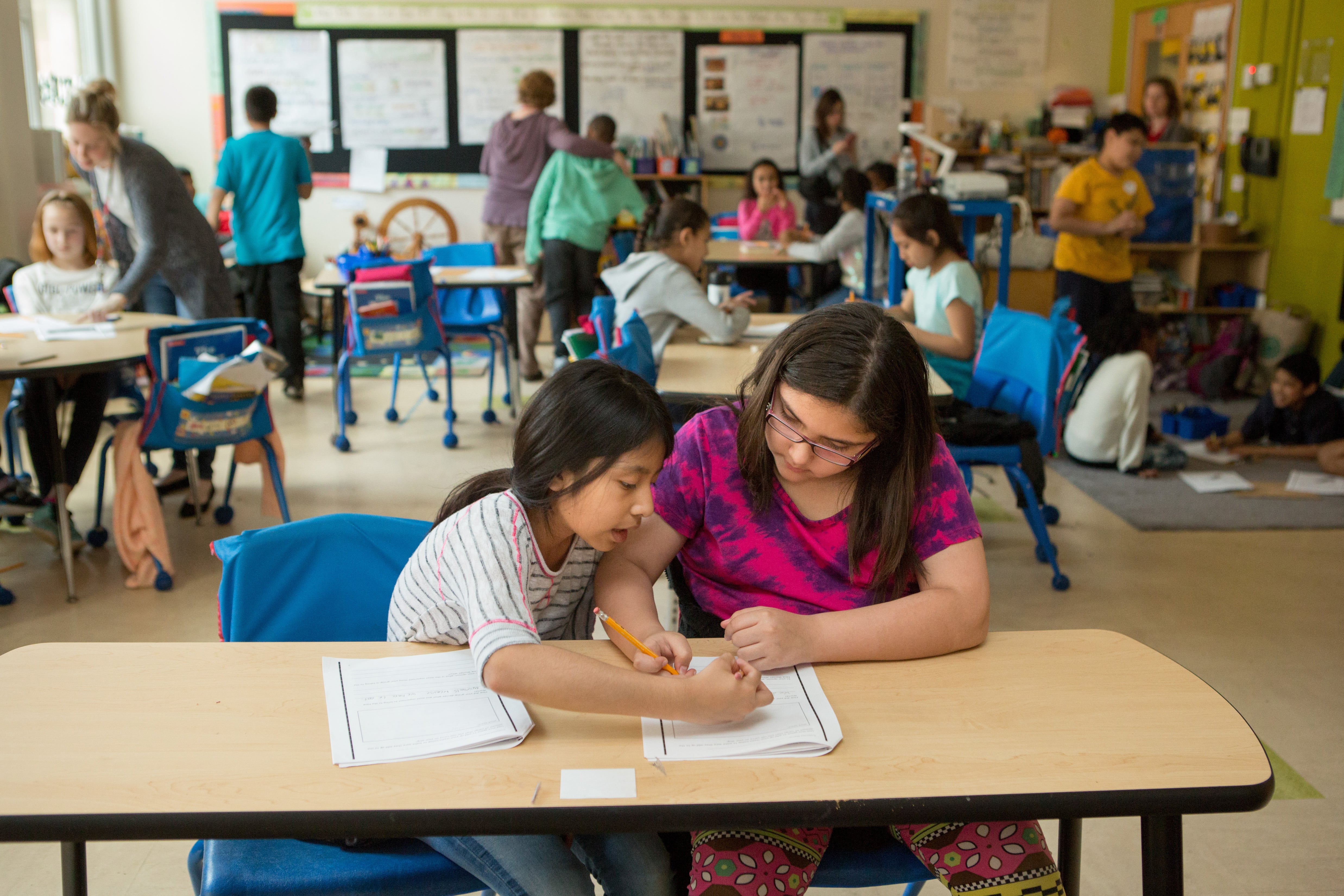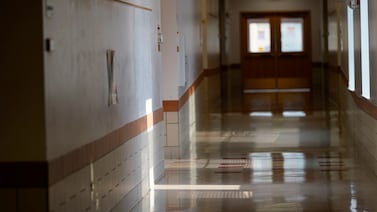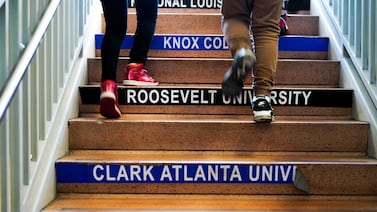Sign up for Chalkbeat’s free weekly newsletter to keep up with how education is changing across the U.S.
Academic gaps between students from low-income backgrounds and their more affluent peers have widened, even as American students as a whole are making a surprising recovery from the pandemic’s disruptions.
And in contrast to the initial sharp decline in test scores during the pandemic, when differences among districts drove much of the decrease for low-income students, gaps have widened in the last year between students from different income levels within the same district.
Those are the findings of a new analysis of student progress between spring 2022 and spring 2023 from The Educational Opportunity Project at Stanford University and a team of researchers that includes Stanford’s Sean Reardon, who studies inequality, and Harvard University’s Thomas Kane, an education professor and economist.
The analysis defies some of the direst predictions about pandemic learning loss even as it confirms others — such as the fear that students who already face the most challenges would fall much further behind and not get what they need to catch up.
The new analysis presents a sunnier picture than a previous one from the testing group NWEA that found that students learned at a similar rate or slower during the 2022-23 school year than in pre-pandemic years, meaning they weren’t making up lost learning.
The analysis relies on federal and state reading and math test data from 30 states accounting for roughly 8,000 school districts and some 15 million students. Because states use different tests and have different thresholds for proficiency, the researchers used a method to put the state test scores onto a common scale and to convert proficiency rates to grade levels, allowing comparisons among school districts in all 30 states. Some states, including New York and Colorado, were excluded because too few students took state tests, while others changed tests.
Most students are still behind their 2019 counterparts, the analysis found, and likely will be for years. But they’re also making greater year-over-year gains than researchers had seen in decades of administration of the National Assessment of Educational Progress, known as the nation’s report card.
The report’s authors called on state and local leaders to make the most of remaining pandemic relief dollars and do more to make sure tutoring, summer school, and other help reaches the students who need it.
“Recovery really is possible, but let’s focus in particular on the communities that have the furthest to go to catch up,” Reardon said in an interview. “And we should worry that the federal money is running out and some of the resources will not be there and states will have to step in.”
Here are three key takeaways from the analysis.
Many students made remarkable gains, but recovery incomplete
Between 2019 and 2022, the study estimates students missed the equivalent of half a year of typical learning in math and a third of a year of reading.
By spring 2023, the average student had recovered about a third of the loss in math — or a sixth of a grade level — and about a quarter of the original loss in reading — roughly one-twelfth of a grade level, the analysis found.
That might not seem like much, Reardon said, but in the decade before the pandemic, students “almost never” made this much additional academic progress in a year. When it did happen, it happened in small affluent districts.
“It’s pretty impressive,” Reardon said. “You moved an entire ship, not just a little dinghy. That’s the good news.”
Students in Pennsylvania and Mississippi made up more ground than the national average in math after experiencing larger-than-average declines between 2019 and 2022. Tennessee students also made up more learning in math, while Illinois students made more progress in reading — and actually did better than their 2019 counterparts.
But even with the growth students seem to be showing in the new analysis, researchers estimate the average student needs at least another year of recovery in math and another two years in reading. In math, only Alabama students scored better than their 2019 counterparts, and Oregon students actually did worse in both reading and math in 2023 than in 2022.
Academic inequality has widened between districts, within districts
One of the most striking findings from the analysis is that gaps between low-income students and those who are better-off have widened, with some of the largest gaps found in Massachusetts and Michigan.
Racial and ethnic gaps are widening too. Black students’ scores on average improved more than white students’ scores between 2022 and 2023, but because Black students’ scores declined so much during the pandemic, the gap remains slightly larger than in 2019. Hispanic students showed relatively little improvement from 2022 to 2023.
An analysis last year by many of the same researchers found that students in the same district experienced similar academic setbacks, regardless of their background. Scores for students from less-affluent backgrounds dropped more on average because they were more likely to live in high-poverty school districts where people experienced more negative effects of the pandemic.
This new analysis finds that many high-poverty districts are helping students make up for learning loss. Overall, they made similar progress to their more affluent neighbors — and the highest-poverty districts actually showed larger-than-average improvements.
But because districts serving lots of students in poverty were further behind to begin with, gaps with higher-income districts grew even when they made similar progress. And in some states, notably Massachusetts, affluent districts made big gains between 2022 and 2023 while high-poverty districts actually lost ground.
And now gaps are opening up between less-affluent students and better-off students within districts. Students’ test scores fell by similar amounts, but some fell onto a trampoline, Reardon said, while others seem to have fallen into a pit of sand.
“We do not know the reason for this, but it is troubling,” the report notes. “Even as student achievement has improved rapidly since 2022, those gains have not been equally shared, even within the same school district.”
As community-wide stresses recede for some families, Reardon said, “the ways that kids in the same places have access to different resources seem to be playing more of a role.”
Students from low-income households often are segregated in very high-needs schools, where the staff is overworked, Reardon said. Some districts may not be targeting help to those who need it most.
Of all the gaps that opened between students from different economic backgrounds, researchers estimate 60% to 70% is due to differences between districts, while the rest is due to differences within districts.
Urgency needed to help student recovery, close gaps
As of this fall, the lowest-income districts still had about 40% of the federal pandemic relief they received. States and school districts have until September to commit that money — and making the best use of it is essential, Reardon said.
The report makes four recommendations:
- Schools should tell parents early in the spring if their children are below grade level.
- Districts should expand summer school seats to accept anyone who signs up.
- Districts should extend the recovery effort throughout the 2024-25 school year by signing tutoring contracts before the September deadline.
- Communities should work together to reduce absenteeism.
States and districts should use all the data at their disposal to ensure the right help — tutoring, counseling, or attendance help — reaches the students who need it most, Reardon said.
The new analysis is accompanied by an interactive map that allows leaders and community members to identify districts making more progress and learn from them.
Districts have had a lot of leeway to decide how to spend pandemic money. States should use incentives to ensure remaining funds go toward academic recovery. And they “may need to complete the final leg of the recovery on their own resources,” the report says.
With advocates pushing states to keep paying for tutoring, those conversations are already starting in many places.
Erica Meltzer is Chalkbeat’s national editor based in Colorado. Contact Erica at emeltzer@chalkbeat.org.






